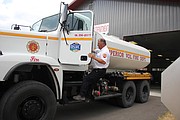DNRC gives water tender to Superior Fire Department
It’s hard to hear yourself talk when driving down the highway in the Superior Fire Department’s water tender. The giant vehicle only gets about four miles to the gallon, and is equipped with two 50-gallon fuel tanks. It’s loaded with 28,000 gallons of water and can rip up the mountains to attack wildfires.
This spring, the Superior Volunteer Fire Department received the monster truck from the Montana Department of Natural Resources and Conservation. The Equipment Development Center is a part of Montana’s fire program and supports the DNRC’s fire protection program with fire suppression equipment, including the huge white tender which now sits in the Superior’s Fire Department.
The vehicle was built for the military with a giant all-wheel drive system, explained fire chief Steve Temple. When used by the military it was equipped with a grappling hook and when a Humvee blew up from an explosive in battle, the vehicle would come in and hook it and drive to safety.
“There are monster motors and traction on here,” Temple said.
With very few miles on the vehicle, they were demilitarized and DNRC received them. The DNRC then equipped them with a water tank. The tanker is owned by the state but maintained by the county.
The truck can reach speeds up to 70 mph and is a bit of a climb to get in and out of. Temple explained that it has an automatic transmission system and is easier to operate than the other department water tender, which has a manual transmission.
Inside the truck is a panel filled with switches and buttons and is labelled TE 3 for “water tender 3.” A much-needed piece of equipment as the fire season is in full swing, and several local fires have kept crews busy over the past few weeks with dry condition and hot temperatures in the forecast.





